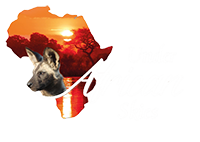Animals of Hluhluwe
Animals of Hluhluwe
Animals of Hluhluwe Game Reserve
Animals of Hluhluwe are the Big 5, giraffes, zebras, warthogs, various antelope, cheetah, hyena, wildebees, wild dogs, an abundance of birdlife and many other animals.
The lion, elephant, leopard, buffalo and rhino are known as the Big 5 Animals not because of their size, but because hunters found them very difficult to hunt due to their aggressive nature when threatened or injured.
Hluhluwe boasts the largest, tallest and fastest land mammals in the world. This park also has the world’s largest rhino population. Each animal of Hluhluwe is uniquely adapted to the environment and surroundings. Whilst on safari you will learn more about each animal. You can experience the animals either on a hike, in an airconditioned vehicle or an open game viewer.
On a sweltering hot summer’s day you may be fortunate enough to see a lion in a tree, trying to escape the heat and flies. Large herds of elephants making their way to the river. Rhinos wallowing in the mud, trying to cool off. And many more other animals’ behaviour.
Animals of Hluhluwe are magnificent. Observing the animals in the African bush is very impressive. These animals roam a vast area consisting of 960 km² of hilly topography consisting of 300km² on the Hluhluwe side and 660km² on the Imfolozi side of which 360km² is wilderness area.
This impression will stay with you forever.
Big 5 Animals
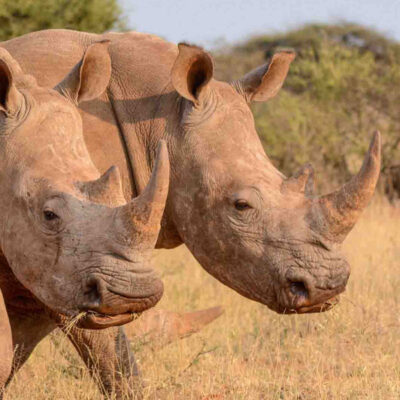
White Rhino
Hluhluwe Imfolozi Game Reserve is well known for its white rhino conservation efforts. The white rhino is also known as the square-lipped rhino. They use their flat, square lips to effectively cut and eat grass, as they are grazers, which means they only eat vegetation off the ground. The white rhino is the larger of the two African rhino species. They have two horns on the end of their nose. The front horn is usually much larger than the inner horn. The white rhino calf is always in front of the female as they are generally in the open savanna, this allows the female to keep an eye out for danger and watch her calf.
Details:
Weight: 1800kg to 3000 kg
Height: 1.5m to 1.8m
Group of Rhinos: Crash
Chances of sightings on Safari:


White Rhino
Hluhluwe Imfolozi Game Reserve is well known for its white rhino conservation efforts. The white rhino is also known as the square-lipped rhino. They use their flat, square lips to effectively cut and eat grass, as they are grazers, which means they only eat vegetation off the ground. The white rhino is the larger of the two African rhino species. They have two horns on the end of their nose. The front horn is usually much larger than the inner horn. The white rhino calf is always in front of the female as they are generally in the open savanna, this allows the female to keep an eye out for danger and watch her calf.
Details:
Weight: 1800kg to 3000 kg
Height: 1.5m to 1.8m
Group of Rhinos: Crash
Chances of sightings on Safari:

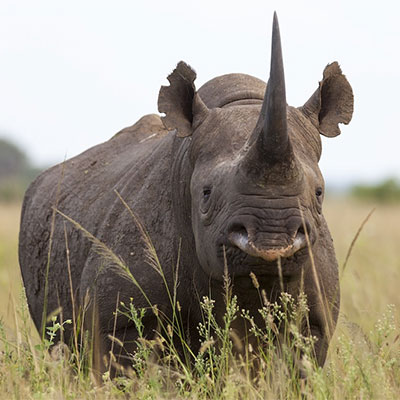
Black Rhino
Black rhino conservation is of utmost importance at Hluhluwe Imfolozi National Park. Black rhinos are also known as the hook-lipped rhino. They are browsers and use their hooked lip to pick at bushes and low branches for food. The black rhino is the smaller of the two African species. They can be either solitary and territorial, or semi-social and less aggressively-territorial, depending on the habitat. Black rhino calves follow from behind because if the female sensors danger it will run first crashing through the dense bush. They are also known for being shy and more aggressive of the two African species.
Details:
Weight: 900kg to 1 350 kg
Height: 1.6m
Group of Rhino: Crash
Chances of sightings on Safari:


Black Rhino
Black rhino conservation is of utmost importance at Hluhluwe Imfolozi National Park. Black rhinos are also known as the hook-lipped rhino. They are browsers and use their hooked lip to pick at bushes and low branches for food. The black rhino is the smaller of the two African species. They can be either solitary and territorial, or semi-social and less aggressively-territorial, depending on the habitat. Black rhino calves follow from behind because if the female sensors danger it will run first crashing through the dense bush. They are also known for being shy and more aggressive of the two African species.
Details:
Weight: 900kg to 1 350 kg
Height: 1.6m
Group of Rhino: Crash
Chances of sightings on Safari:

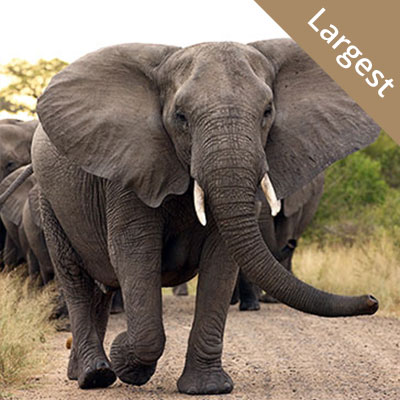
Elephant
African Elephants are regularly seen in Hluhluwe Imfolozi. It is the world’s largest land mammal. They have large trunks that are used to breathe, drink, eat, smell, snorkel, communicate, used as a ‘hand’ to touch, feel, hold, grab, pull, and many other uses. An Elephant’s skin is 2.5 cms thick, dark grey, and has folds and wrinkles. The folds and wrinkles help them retain more water than smooth skin and keeps them cool. The most important function of their wide floppy ears is to keep them cool. Elephants have large thick legs to compensate for their heavy bodies.
Details:
Height: 2.2m – 4m
Group of Elephants: Herd or a Parade
Chances of sightings on Safari:


Elephant
African Elephants are regularly seen in Hluhluwe Imfolozi. It is the world’s largest land mammal. They have large trunks that are used to breathe, drink, eat, smell, snorkel, communicate, used as a ‘hand’ to touch, feel, hold, grab, pull, and many other uses. An Elephant’s skin is 2.5 cms thick, dark grey, and has folds and wrinkles. The folds and wrinkles help them retain more water than smooth skin and keeps them cool. The most important function of their wide floppy ears is to keep them cool. Elephants have large thick legs to compensate for their heavy bodies.
Details:
Height: 2.2m – 4m
Group of Elephants: Herd or a Parade
Chances of sightings on Safari:


Lion
Lions in Hluhluwe Imfolozi sometimes climb trees, however this is not a common sighting. Lions have a stealthy built, compact bodies and powerful forelegs. Their coats are tawny, and adult males have shaggy manes that are reddish-brown to black. Lions are social and the only cats that live in groups. Their social behaviour is to strengthen their ties with the members of the group. And to defend and expand their territory to pass onto female offspring. this could also be due to their close genetic relatedness among a pride’s females. Seeing a lion in the wild is being lucky. But people do see them in Hluhluwe.
Details:
Height: 1.1m – 1.2m
Group of Lions – pride
Chances of sightings on Safari:


Lion
Lions in Hluhluwe Imfolozi sometimes climb trees, however this is not a common sighting. Lions have a stealthy built, compact bodies and powerful forelegs. Their coats are tawny, and adult males have shaggy manes that are reddish-brown to black. Lions are social and the only cats that live in groups. Their social behaviour is to strengthen their ties with the members of the group. And to defend and expand their territory to pass onto female offspring. this could also be due to their close genetic relatedness among a pride’s females. Seeing a lion in the wild is being lucky. But people do see them in Hluhluwe.
Details:
Height: 1.1m – 1.2m
Group of Lions – pride
Chances of sightings on Safari:

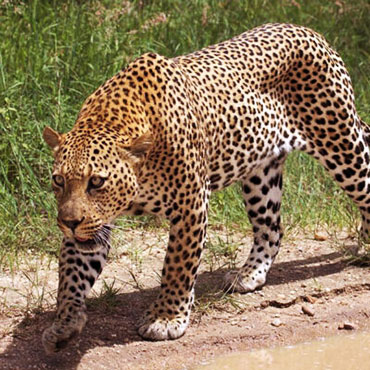
Leopard
Leopards are a rare sighting in Hluhluwe Imfolozi Game Reserve as they are very elusive cats. They are golden with distinctive dark spots that are called rosettes. Leopards are excellent tree climbers and are very strong. They have the ability to drag a carcass up a tree as heavy as their own body weight.
Details:
Height: 0.50m – 0.70m
Group of Leopards – Leap
Chances of sightings on Safari:


Leopard
Leopards are a rare sighting in Hluhluwe Imfolozi Game Reserve as they are very elusive cats. They are golden with distinctive dark spots that are called rosettes. Leopards are excellent tree climbers and are very strong. They have the ability to drag a carcass up a tree as heavy as their own body weight.
Details:
Height: 0.50m – 0.70m
Group of Leopards – Leap
Chances of sightings on Safari:

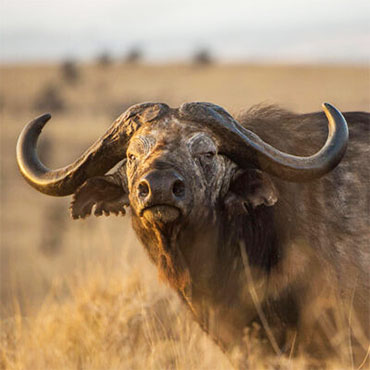
Buffalo
Hluhluwe Imfolozi has huge herds of buffalo. They have huge bodies covered with black hair and massive horns that meet in the middle to form a “helmet”. When a buffalo herd comes under threat from a predator they form a circle around their young and weak. All of the adults face outwards in an effort to hide the vulnerable. They lower their heads and form a protective barrier with their horns. The buffalo is the most aggressive of the Big 5. They are however social animals and live in big herds. So you might see a herd of a hundred strong or more.
Details:
Weight: 450kg – 550kg
Height: 1.3m – 1.5m
Group of Buffalos: Herd
Chances of sightings on Safari:


Buffalo
Hluhluwe Imfolozi has huge herds of buffalo. They have huge bodies covered with black hair and massive horns that meet in the middle to form a “helmet”. When a buffalo herd comes under threat from a predator they form a circle around their young and weak. All of the adults face outwards in an effort to hide the vulnerable. They lower their heads and form a protective barrier with their horns. The buffalo is the most aggressive of the Big 5. They are however social animals and live in big herds. So you might see a herd of a hundred strong or more.
Details:
Weight: 450kg – 550kg
Height: 1.3m – 1.5m
Group of Buffalos: Herd
Chances of sightings on Safari:

Special Mammals
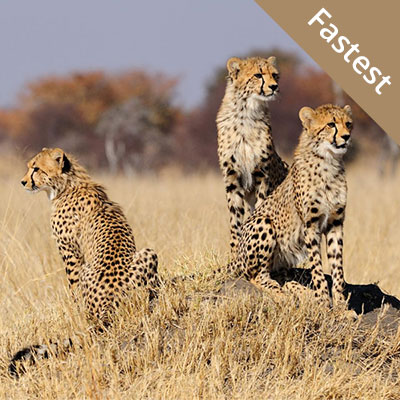
Cheetah
Cheetahs are the fastest land animal in the world. Hluhluwe National Park boasts a healthy population of these skittish animals. They have long legs and slender bodies can reach speeds up to 112km/h. Their high-speed chases can only last a few hundred meters before they tire. What cheetahs lack in strength they make up for in speed. They are over specialised for speed, which makes them almost defenceless against larger predators. They hunt during the day to avoid the attention of nocturnal predators.
Details:
Weight : 20kg – 65kg
Height: 70cm – 90cm
Group of Cheetah – Coalition
Chances of sightings on Safari:


Cheetah
Cheetahs are the fastest land animal in the world. Hluhluwe National Park boasts a healthy population of these skittish animals. They have long legs and slender bodies can reach speeds up to 112km/h. Their high-speed chases can only last a few hundred meters before they tire. What cheetahs lack in strength they make up for in speed. They are over specialised for speed, which makes them almost defenceless against larger predators. They hunt during the day to avoid the attention of nocturnal predators.
Details:
Weight : 20kg – 65kg
Height: 70cm – 90cm
Group of Cheetah – Coalition
Chances of sightings on Safari:

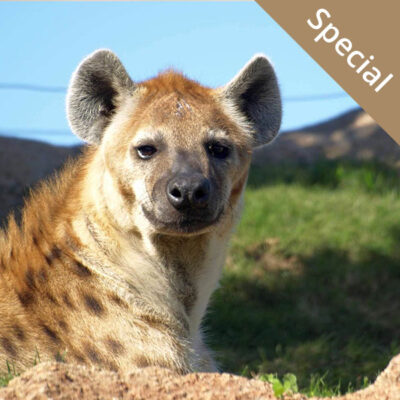
Spotted Hyena
Spotted hyenas can be seen in Hluhluwe Imfolozi. Hyenas are uniquely built, they have large heads with round ears, their front legs are heavily built and longer than their hind legs. This adaptation helps them carry weights of up to 10kgs back to the den to feed their pups. The hyenas’ short hind legs gives them loping gait, this minimises energy used, making it possible for them to cover long distances. They have large hearts giving them the endurance for the long chases.
Of all mammals the spotted hyena has the most powerful bite. Hyenas are known as scavengers however they are excellent hunters.
Details:
Weight: 70kg
Height: 70cm to 90cm
Group of Hyenas: Clan
Chances of sightings on Safari:


Spotted Hyena
Spotted hyenas can be seen in Hluhluwe Imfolozi. Hyenas are uniquely built, they have large heads with round ears, their front legs are heavily built and longer than their hind legs. This adaptation helps them carry weights of up to 10kgs back to the den to feed their pups. The hyenas’ short hind legs gives them loping gait, this minimises energy used, making it possible for them to cover long distances. They have large hearts giving them the endurance for the long chases.
Of all mammals the spotted hyena has the most powerful bite. Hyenas are known as scavengers however they are excellent hunters.
Details:
Weight: 70kg
Height: 70cm to 90cm
Group of Hyenas: Clan
Chances of sightings on Safari:

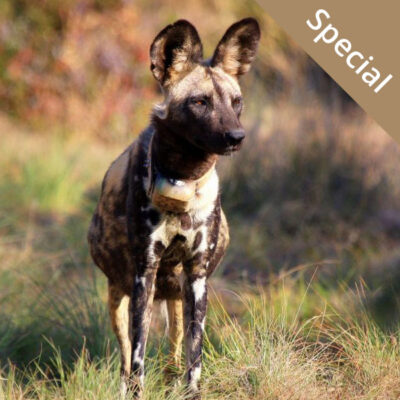
Wild Dog
Hluhluwe Game Reserve has a small population of wild dogs. These painted dogs are built for hunting. Their lean bodies with long legs that make them formidable hunters. The wild dogs’ secret to hunting is their stamina and teamwork.They wear the prey down with long chases that can be as long as 5kms. When the lead dog of the chase starts to tire, it will pull back, and the next dog will take its place.
Wild dogs are nomadic. However, when a member of the pack is sick or injured they will stay in the same place, taking care of the sick dog until it is well enough to be on the move again.
Details:
Height 75cm – 112cm
Group of Wild Dogs : Pack
Chances of sightings on Safari:


Wild Dog
Hluhluwe Game Reserve has a small population of wild dogs. These painted dogs are built for hunting. Their lean bodies with long legs that make them formidable hunters. The wild dogs’ secret to hunting is their stamina and teamwork.They wear the prey down with long chases that can be as long as 5kms. When the lead dog of the chase starts to tire, it will pull back, and the next dog will take its place.
Wild dogs are nomadic. However, when a member of the pack is sick or injured they will stay in the same place, taking care of the sick dog until it is well enough to be on the move again.
Details:
Height 75cm – 112cm
Group of Wild Dogs : Pack
Chances of sightings on Safari:

Other Mammals

Giraffe
The tallest mammal in the world is present in Hluhluwe Game Reserve. A giraffe’s heart, can weigh more than 11 kg, measures about 60 cm’s and has to pump blood all the way up to the brain against the hydrostatic pressure of the blood. They have extremely high heart rates for their size, at 150 beats per minute.
Giraffes give birth standing up, and get a rude welcome into the world by falling 1.8m to the ground. This is how the amniotic sac and umbilical cord breaks. The fall does not hurt the baby giraffe at all, but makes it take a deep, first breath.
Details:
Height: 4.3m – 5.7m
Group of Giraffes: Journey
Chances of sightings on Safari:


Giraffe
The tallest mammal in the world is present in Hluhluwe Game Reserve. A giraffe’s heart, can weigh more than 11 kg, measures about 60 cm’s and has to pump blood all the way up to the brain against the hydrostatic pressure of the blood. They have extremely high heart rates for their size, at 150 beats per minute.
Giraffes give birth standing up, and get a rude welcome into the world by falling 1.8m to the ground. This is how the amniotic sac and umbilical cord breaks. The fall does not hurt the baby giraffe at all, but makes it take a deep, first breath.
Details:
Height: 4.3m – 5.7m
Group of Giraffes: Journey
Chances of sightings on Safari:

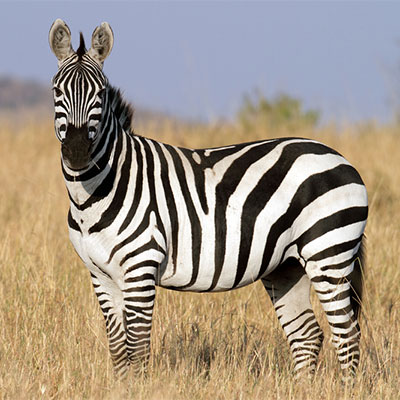
Zebra
A typical African scene when you see zebras in the vast openness of Imfolozi Game Reserve. The pattern of a zebras stripes are unique to each individual, making them each as unique as a fingerprint is to humans. A foal can probably imprint its mother’s pattern and scent within the first few days of being born. Zebra’s stripes create a dazzling effect to confuse their predators on the hunt. It makes it difficult for predators to target one when the herd starts to run.
Another function is to ward off flies that bite. The striped coat has the same effect with flies as it does on predators. Zebras’ black and white stripes function is used for heat dissipation as well, which leads to a more effective cooling.
Details:
Weight: 350kg – 450kg
Height: 1.05m – 1.50m
Group of Zebras: Dazzle
Chances of sightings on Safari:


Zebra
A typical African scene when you see zebras in the vast openness of Imfolozi Game Reserve. The pattern of a zebras stripes are unique to each individual, making them each as unique as a fingerprint is to humans. A foal can probably imprint its mother’s pattern and scent within the first few days of being born. Zebra’s stripes create a dazzling effect to confuse their predators on the hunt. It makes it difficult for predators to target one when the herd starts to run.
Another function is to ward off flies that bite. The striped coat has the same effect with flies as it does on predators. Zebras’ black and white stripes function is used for heat dissipation as well, which leads to a more effective cooling.
Details:
Weight: 350kg – 450kg
Height: 1.05m – 1.50m
Group of Zebras: Dazzle
Chances of sightings on Safari:

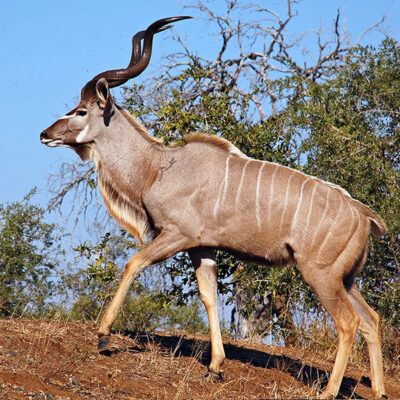
Kudu
Kudus males are the second tallest antelope, they can clear a fence of 2.5m. The females are smaller and hornless whilst the males have beautiful spiralled horns. Kudu’s coats have disruptive markings which helps them blend in with their surroundings. When fleeing from danger in dense bush their horns don’t get in the way, as they lift up their chins so that the horns lie flat at shoulder level.
Details:
Weight: 150kg – 220kg
Height: 1.45m
Group of Kudus: Cluster
Chances of sightings on Safari:


Kudu
Kudus males are the second tallest antelope, they can clear a fence of 2.5m. The females are smaller and hornless whilst the males have beautiful spiralled horns. Kudu’s coats have disruptive markings which helps them blend in with their surroundings. When fleeing from danger in dense bush their horns don’t get in the way, as they lift up their chins so that the horns lie flat at shoulder level.
Details:
Weight: 150kg – 220kg
Height: 1.45m
Group of Kudus: Cluster
Chances of sightings on Safari:

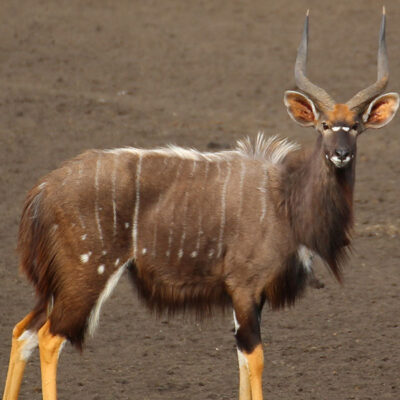
Nyala
From all antelope in the world the male and female nyala have the greatest differences. Males are twice the size of females, have horns and their overall body colour is grey. Females do not have horns and their overall body colour is brown to chestnut. Males are born looking like females and as they mature their appearance changes.
Details:
Height: 135m – 195 cm
Group of Nyalas: Cluster
Chances of sightings on Safari:


Nyala
From all antelope in the world the male and female nyala have the greatest differences. Males are twice the size of females, have horns and their overall body colour is grey. Females do not have horns and their overall body colour is brown to chestnut. Males are born looking like females and as they mature their appearance changes.
Details:
Height: 135m – 195 cm
Group of Nyalas: Cluster
Chances of sightings on Safari:

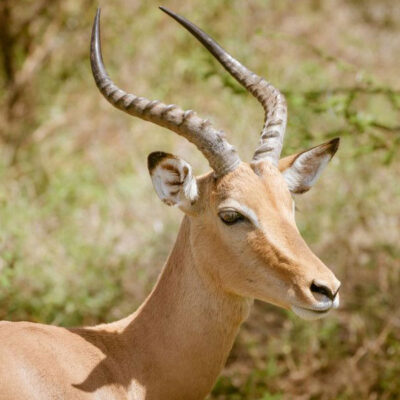
Impala
The first antelope you encounter in Hluhluwe Game Reserve will most likely be Impala. They are most common but also the most graceful antelope in Africa.
Impalas have a harem structure where one large dominant male will overlook and constantly herd his group of females close to him. The rut (breeding season) peaks, typically in May. The impala males start to roar and fight frequently and intensely with challengers. They also start thrashing bushes with their horns. The males have horn clashes and pushing fights. Impalas give birth within a few days of each other, this is called synchronous birthing, this is to maximize offspring survival.
Details:
Weight: 40kg – 45kg
Height: 90cm
Group of Impalas: Rank
Chances of sightings on Safari:

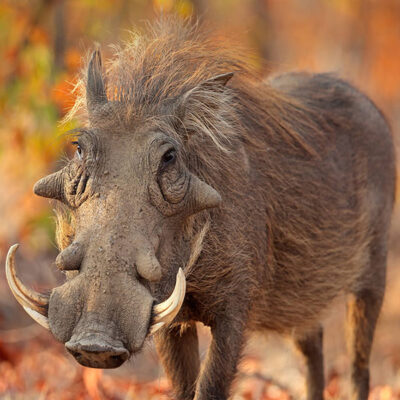
Warthog
A common sighting in Hluhluwe is warthogs grazing on their forelegs. They can graze like this as they have calloused pads on their wrists which help protect them whilst they graze on their bent forelegs. These pads form quite early in their foetal development stage.
Warthogs use their tusks for digging, fighting with rivals and defending themselves against predators. Adult warthogs defend themselves vigorously and often turn on the predator, sometimes causing the predator serious injuries with their tusks.
Details:
Height: 64cm – 85cm
Group of Warthogs: Sounders
Chances of sightings on Safari:

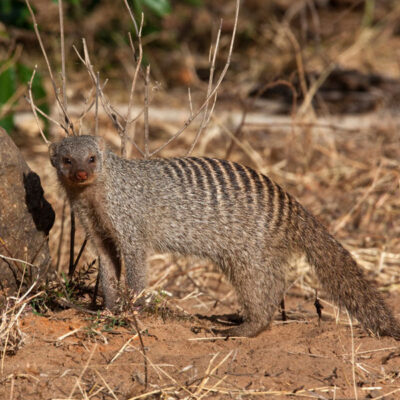
Banded Mongoose
Banded mongoose raise their young very interestingly, as it’s all about synchronicity from pregnancy to birth to being independent. Litters are born either on the same day or a few days apart from each other. Each female gives birth to a litter ranging from two to six pups. The pups are born blind and open their eyes when they are around 10 days old. Pups being cared for by the group are permitted to suckle from any female that is lactating. The synchronised breeding allows for litters to be weaned collectively among females. For the first 4 weeks, pups are kept underground and are taken care of by one to three adults. When they are 4 weeks old they are allowed to go on foraging trips. Each pup is accompanied by an ‘escort’ which helps them find food and protects them from danger. Eventually at three months old the pups become nutritionally independent.
Details:
Snout to tail: 41cm
Group of Mongooses: Business
Chances of sightings on Safari:


Impala
The first antelope you encounter in Hluhluwe Game Reserve will most likely be Impala. They are most common but also the most graceful antelope in Africa.
Impalas have a harem structure where one large dominant male will overlook and constantly herd his group of females close to him. The rut (breeding season) peaks, typically in May. The impala males start to roar and fight frequently and intensely with challengers. They also start thrashing bushes with their horns. The males have horn clashes and pushing fights. Impalas give birth within a few days of each other, this is called synchronous birthing, this is to maximize offspring survival.
Details:
Weight: 40kg – 45kg
Height: 90cm
Group of Impalas: Rank
Chances of sightings on Safari:


Warthog
A common sighting in Hluhluwe is warthogs grazing on their forelegs. They can graze like this as they have calloused pads on their wrists which help protect them whilst they graze on their bent forelegs. These pads form quite early in their foetal development stage.
Warthogs use their tusks for digging, fighting with rivals and defending themselves against predators. Adult warthogs defend themselves vigorously and often turn on the predator, sometimes causing the predator serious injuries with their tusks.
Details:
Height: 64cm – 85cm
Group of Warthogs: Sounders
Chances of sightings on Safari:


Banded Mongoose
Banded mongoose raise their young very interestingly, as it’s all about synchronicity from pregnancy to birth to being independent. Litters are born either on the same day or a few days apart from each other. Each female gives birth to a litter ranging from two to six pups. The pups are born blind and open their eyes when they are around 10 days old. Pups being cared for by the group are permitted to suckle from any female that is lactating. The synchronised breeding allows for litters to be weaned collectively among females. For the first 4 weeks, pups are kept underground and are taken care of by one to three adults. When they are 4 weeks old they are allowed to go on foraging trips. Each pup is accompanied by an ‘escort’ which helps them find food and protects them from danger. Eventually at three months old the pups become nutritionally independent.
Details:
Snout to tail: 41cm
Group of Mongooses: Business
Chances of sightings on Safari:

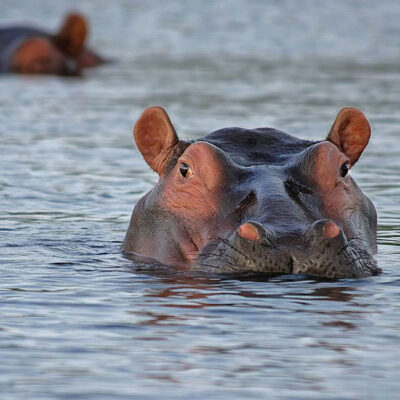
Hippo
Not a very common sighting on a game drive in Hluhluwe Game Reserve. The closest living relatives to hippos are whales, dolphins and porpoises however, hippos can’t swim like them, they walk underwater. Hippos can’t breathe underwater but can stay submerged for about 5 minutes on a single breath. Newborn hippos are only able to hold their breath for about 40 seconds at a time. Depending on the depth of the water these newborns need somewhere to regain their strength, so mothers will allow their newborns to climb onto their backs/necks.
Details:
Height – 1.4m to 1.5m
Group of Hippos – Pod
Chances of sightings on Safari:


Hippo
Not a very common sighting on a game drive in Hluhluwe Game Reserve. The closest living relatives to hippos are whales, dolphins and porpoises however, hippos can’t swim like them, they walk underwater. Hippos can’t breathe underwater but can stay submerged for about 5 minutes on a single breath. Newborn hippos are only able to hold their breath for about 40 seconds at a time. Depending on the depth of the water these newborns need somewhere to regain their strength, so mothers will allow their newborns to climb onto their backs/necks.
Details:
Height – 1.4m to 1.5m
Group of Hippos – Pod
Chances of sightings on Safari:

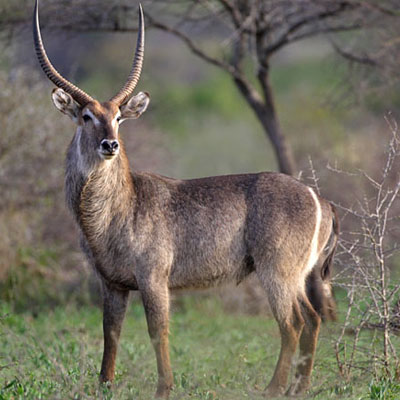
Waterbuck
Waterbuck are grey, large and long haired antelope. They are famous for the ring on its rump, which serves as a follow me sign. Waterbuck are very water dependent and prone to dehydration. They drink the most water of all antelope. Waterbuck are always found within a 5km radius from water. When in danger they seek safety in water to save itself. The Waterbuck’s hair is hollow which allows for extra buoyancy when they swim. This helps them to keep their heads above water.
Details:
Height: 1.3m
Group of Waterbucks: Herd
Chances of sightings on Safari:


Waterbuck
Waterbuck are grey, large and long haired antelope. They are famous for the ring on its rump, which serves as a follow me sign. Waterbuck are very water dependent and prone to dehydration. They drink the most water of all antelope. Waterbuck are always found within a 5km radius from water. When in danger they seek safety in water to save itself. The Waterbuck’s hair is hollow which allows for extra buoyancy when they swim. This helps them to keep their heads above water.
Details:
Height: 1.3m
Group of Waterbucks: Herd
Chances of sightings on Safari:

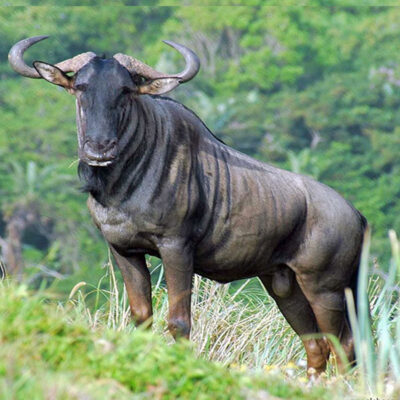
Wildebeest
Wildebeest is Dutch for “wild beast”. They are also known as gnus, this name derives from the sound they make. Their odd looking slanted body serves a purpose, the slanted back is due to their longer forelegs which allows them to canter long distances. Canter is an energy-conserving gait, a pace faster than a walk.
Wildebeest gives birth to a single calf in the middle of the herd, which is unlike other antelope species that find an isolated place. Calves are able to walk within minutes after they are born and can run with the herd a few days after birth.
Details:
Weight: 120kg – 270kg
Height: 1.27m – 1.47 m
Group of Wildebeests: Implausibility
Chances of sightings on Safari:


Wildebeest
Wildebeest is Dutch for “wild beast”. They are also known as gnus, this name derives from the sound they make. Their odd looking slanted body serves a purpose, the slanted back is due to their longer forelegs which allows them to canter long distances. Canter is an energy-conserving gait, a pace faster than a walk.
Wildebeest gives birth to a single calf in the middle of the herd, which is unlike other antelope species that find an isolated place. Calves are able to walk within minutes after they are born and can run with the herd a few days after birth.
Details:
Weight: 120kg – 270kg
Height: 1.27m – 1.47 m
Group of Wildebeests: Implausibility
Chances of sightings on Safari:

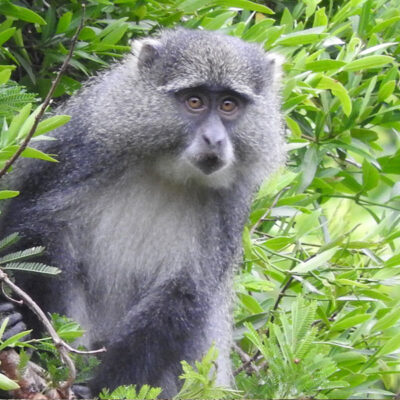
Samango Monkey
Samango monkeys are also known as the white throated monkey. They are a rare sighting however you can see them in Hluhluwe Game Reserve. The Samango monkey’s tail is a third longer than its body. Their diet includes fruits, insects, flowers, leaves and insects.
Details:
Weight – 5kg to 9kg
Height – 1.1m
Group of Samango Monkeys: Troop
Chances of sightings on Safari:


Samango Monkey
Samango monkeys are also known as the white throated monkey. They are a rare sighting however you can see them in Hluhluwe Game Reserve. The Samango monkey’s tail is a third longer than its body. Their diet includes fruits, insects, flowers, leaves and insects.
Details:
Weight – 5kg to 9kg
Height – 1.1m
Group of Samango Monkeys: Troop
Chances of sightings on Safari:

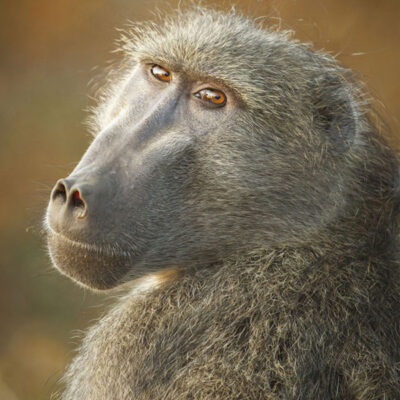
Chacma Baboon
Chacma baboons are the largest members of the monkey family. They are a highly social species and live in groups. When two individuals meet each other they touch noses as a friendly sign. Social grooming is used to reinforce social bonds, as well as to remove parasites and debris from their fur.
Baboons have ischial callosities, which are built in seat cushions that allow baboons to sit comfortably for a fair amount of time whilst feeding and sitting on hard surfaces like tree branches.
Details:
Weight: 30kg – 40kg
Height: 0.73m
Group of Baboons: Troop
Chances of sightings on Safari:


Chacma Baboon
Chacma baboons are the largest members of the monkey family. They are a highly social species and live in groups. When two individuals meet each other they touch noses as a friendly sign. Social grooming is used to reinforce social bonds, as well as to remove parasites and debris from their fur.
Baboons have ischial callosities, which are built in seat cushions that allow baboons to sit comfortably for a fair amount of time whilst feeding and sitting on hard surfaces like tree branches.
Details:
Weight: 30kg – 40kg
Height: 0.73m
Group of Baboons: Troop
Chances of sightings on Safari:

Other Animals
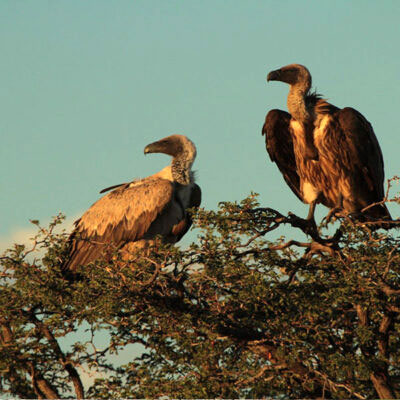
Vulture
A vulture is a scavenging bird of prey, they feed on carcasses of dead animals. Their heads and necks are relatively bare so that when they feed on rotting carcasses, bacteria and other parasites cannot burrow into their thick feathers to cause infections. A vulture’s stomach acid is considerably stronger and more corrosive than any other animal or bird.
A group of vultures is called a committee, venue, or volt. In flight, a flock of vultures is a kettle, and when the birds are feeding together at a carcass, the group is called a wake.
Details:
Weight: 4kg – 7kg
Length of body: 78cm – 98cm
Group of Vultures – Committee
Chances of sightings on Safari:


Vulture
A vulture is a scavenging bird of prey, they feed on carcasses of dead animals. Their heads and necks are relatively bare so that when they feed on rotting carcasses, bacteria and other parasites cannot burrow into their thick feathers to cause infections. A vulture’s stomach acid is considerably stronger and more corrosive than any other animal or bird.
A group of vultures is called a committee, venue, or volt. In flight, a flock of vultures is a kettle, and when the birds are feeding together at a carcass, the group is called a wake.
Details:
Weight: 4kg – 7kg
Length of body: 78cm – 98cm
Group of Vultures – Committee
Chances of sightings on Safari:


Crocodile
Fossil records prove that crocodiles once walked the earth with dinosaurs. Crocodiles are the ultimate survivors. Their heart rates can be slowed down during dives, oxygenated blood only flows to the organs such as the brain and heart. Crocodiles can stay underwater for up to 2 hours, during these dives their heart rates drop drastically to about 2 or 3 beats per minute.
Details:
Length: 2.5m – 4m
Group of Crocodiles – Congregation or Bask
Chances of sightings on Safari:


Fish Eagle
The fish eagle is a piscivore for which they are equipped. Their toes are coated in sharp barbs, called spiricules, which help it to grasp fish and other slippery prey. The African Fish eagle is classified as a kleptoparasite which means it steals prey from other birds.
The fish eagle’s call is very well known and distinguished that it is known as the “sound of Africa”.
Details:
Wingspan: 1.75m – 2.10m
Group of Fish Eagles – Convocation
Chances of sightings on Safari:


Fish Eagle
The fish eagle is a piscivore for which they are equipped. Their toes are coated in sharp barbs, called spiricules, which help it to grasp fish and other slippery prey. The African Fish eagle is classified as a kleptoparasite which means it steals prey from other birds.
The fish eagle’s call is very well known and distinguished that it is known as the “sound of Africa”.
Details:
Wingspan: 1.75m – 2.10m
Group of Fish Eagles – Convocation
Chances of sightings on Safari:


Crocodile
Fossil records prove that crocodiles once walked the earth with dinosaurs. Crocodiles are the ultimate survivors. Their heart rates can be slowed down during dives, oxygenated blood only flows to the organs such as the brain and heart. Crocodiles can stay underwater for up to 2 hours, during these dives their heart rates drop drastically to about 2 or 3 beats per minute.
Details:
Length: 2.5m – 4m
Group of Crocodiles – Congregation or Bask
Chances of sightings on Safari:

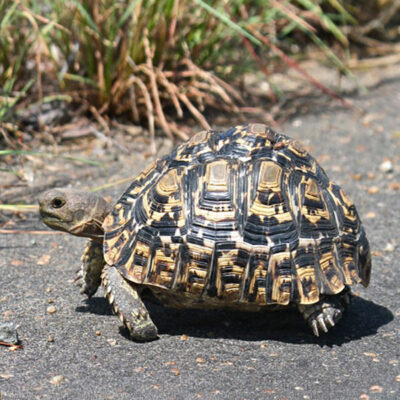
Leopard Tortoise
Leopard tortoise is part of the little 5 (the rhino beetle, the red-billed buffalo weaver, elephant shrew and the antlion). They eat old hyena scat for the high calcium content, this is called coprophagia. They also chew on old bones, known as osteophagia.
During the dry season the leopard tortoise stores water in their bursa sac. This stored water is needed during times of drought or to moisten soil to easily dig a pit in which to lay eggs. If you see a leopard tortoise you should not pick them up, as they are frightened when they suddenly find themselves so far from the ground. If a tortoise is threatened, they will urinate profusely and release the contents of its bursa sac. They use this as a repellent for their predators.
Details:
Length: 40cm
Group of Tortoises: Creep
Chances of sightings on Safari:


Martial Eagle
Hluhluwe Imfolozi is home to the largest eagle in Africa, the martial eagle. They weigh almost 6.5 kg and have a wingspan of about 2.6 meters. Their diet consists of monitor lizards, venomous snakes, waterbirds such as herons and storks, ground dwelling birds, young antelope and even predatory cats such as jackals. Their territories range from 150km² on average, and extend to more than 1000km². They roam such a large area due to differences in food supply.
Details:
Wingspan: 1.90m – 2.60m
Group of Martial Eagle: Convocation
Chances of sightings on Safari:


Martial Eagle
Hluhluwe Imfolozi is home to the largest eagle in Africa, the martial eagle. They weigh almost 6.5 kg and have a wingspan of about 2.6 meters. Their diet consists of monitor lizards, venomous snakes, waterbirds such as herons and storks, ground dwelling birds, young antelope and even predatory cats such as jackals. Their territories range from 150km² on average, and extend to more than 1000km². They roam such a large area due to differences in food supply.
Details:
Wingspan: 1.90m – 2.60m
Group of Martial Eagle: Convocation
Chances of sightings on Safari:


Leopard Tortoise
Leopard tortoise is part of the little 5 (the rhino beetle, the red-billed buffalo weaver, elephant shrew and the antlion). They eat old hyena scat for the high calcium content, this is called coprophagia. They also chew on old bones, known as osteophagia.
During the dry season the leopard tortoise stores water in their bursa sac. This stored water is needed during times of drought or to moisten soil to easily dig a pit in which to lay eggs. If you see a leopard tortoise you should not pick them up, as they are frightened when they suddenly find themselves so far from the ground. If a tortoise is threatened, they will urinate profusely and release the contents of its bursa sac. They use this as a repellent for their predators.
Details:
Length: 40cm
Group of Tortoises: Creep
Chances of sightings on Safari:


Oxpecker
Oxpeckers are the birds you see sitting on animals and pecking at them. They play a very important role as they clean animal’s wounds and free them from parasite infestation.
Oxpeckers have a mutualistic relationship with certain animals, such as impalas, giraffes, antelope, zebra, cape buffalo and rhinoceroses, just to name a few. Oxpeckers sit on certain animals targeting the ticks and other small parasites found on the skin and in the coats of these animals. These birds also help clean-up open wounds by eating the rotting wound tissue around it.
Details:
Weight: 0.5kg
Length of Body: 25cm
Group of Oxpeckers: Fling
Chances of sightings on Safari:


Oxpecker
Oxpeckers are the birds you see sitting on animals and pecking at them. They play a very important role as they clean animal’s wounds and free them from parasite infestation.
Oxpeckers have a mutualistic relationship with certain animals, such as impalas, giraffes, antelope, zebra, cape buffalo and rhinoceroses, just to name a few. Oxpeckers sit on certain animals targeting the ticks and other small parasites found on the skin and in the coats of these animals. These birds also help clean-up open wounds by eating the rotting wound tissue around it.
Details:
Weight: 0.5kg
Length of Body: 25cm
Group of Oxpeckers: Fling
Chances of sightings on Safari:

